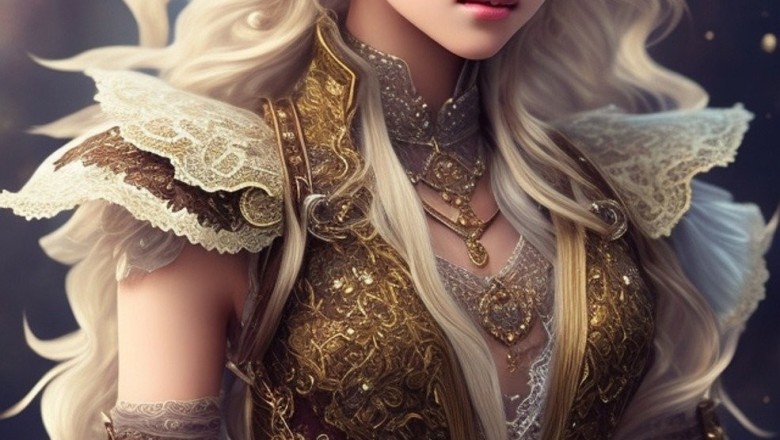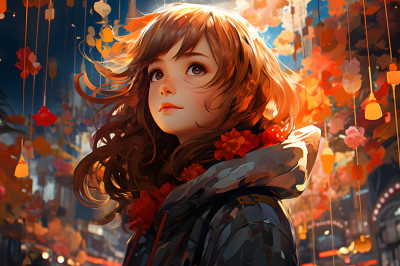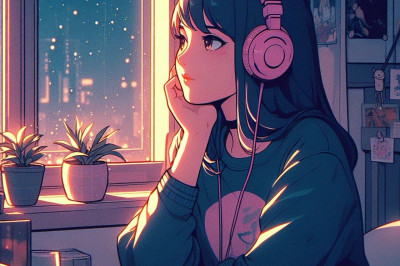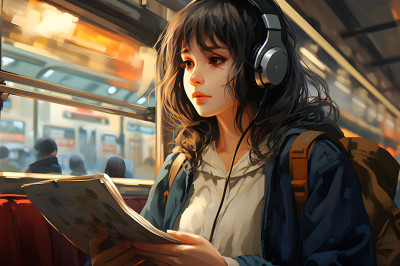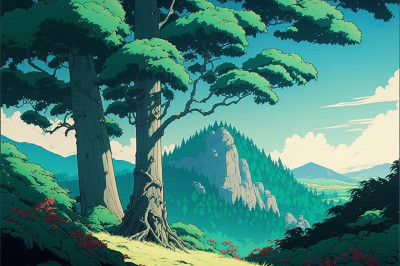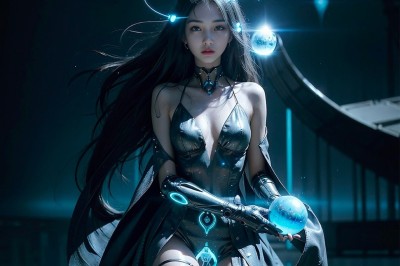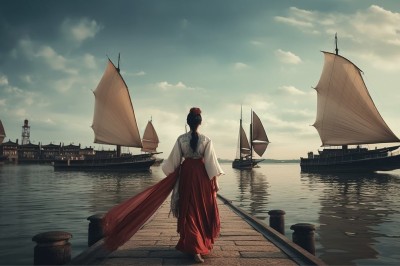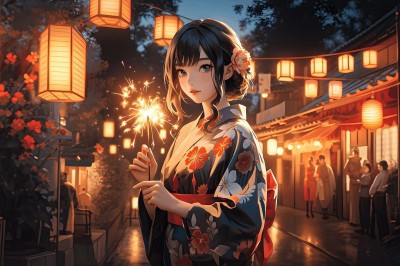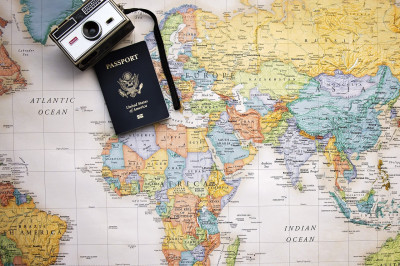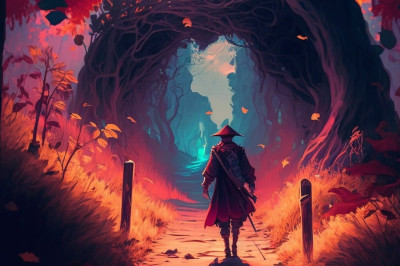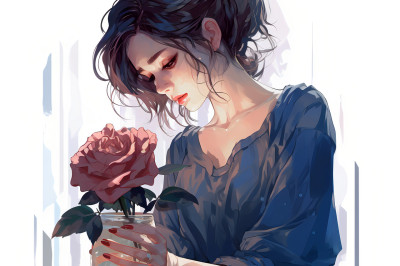The Historical Emergence of Anime
Anime, as we know it today, is a unique form of media that has its roots deeply embedded in Japanese culture. Its origins can be traced back to the early 20th century, with the earliest known Japanese animation dating back to These initial works were heavily influenced by the animation styles and techniques coming from the West, but with a distinct Japanese flavor.
Early Influences and Pioneers
The pioneers of anime, such as Oten Shimokawa, Jun'ichi Kōuchi, and Seitaro Kitayama, were instrumental in developing the early styles and techniques that would lay the foundation for the future of anime. Their work was characterized by simple stories, often with humorous and satirical content, which reflected the societal norms and issues of the time.
The Impact of Manga
Manga, Japanese comic books or graphic novels, have had a significant influence on the development of anime. Many anime are adaptations of popular manga series, and the storytelling techniques and artistic styles found in manga have heavily shaped anime's visual and narrative style. The relationship between manga and anime is symbiotic, with successful anime often boosting the sales of their source material and vice versa.
The Cultural Significance of Anime
Anime has become an integral part of Japanese culture, reflecting and shaping the society's values, norms, and concerns. It serves as a medium for storytelling that can address a wide range of topics, from the mundane to the fantastical, and from the historical to the futuristic.
Reflections of Societal Norms
Anime often mirrors the societal norms of Japan, including the importance of hard work, perseverance, and the value of community. Themes such as the significance of family, respect for elders, and the struggles of adolescence are frequently explored, offering viewers a glimpse into the Japanese way of life.
Technological Progress and Futurism
Japan's rapid technological advancements and its position as a leader in innovation are also reflected in anime. The genre of mecha, which includes giant robots and futuristic machinery, is a prime example of how anime incorporates and celebrates technological progress. Anime often presents a vision of the future that is both optimistic and cautionary, exploring the potential consequences of humanity's reliance on technology.
The Evolution of Anime Styles and Genres
Over the decades, anime has evolved into a diverse medium with a wide array of styles and genres, catering to various audiences. This evolution is a testament to its adaptability and its ability to resonate with viewers both within and outside Japan.
Diverse Genres and Audiences
From action-packed shonen aimed at young boys to the romance and drama of shojo targeted at young girls, anime encompasses a broad spectrum of genres. There are also anime designed for adult audiences, such as seinen and josei, which deal with more mature themes and complex narratives.
Artistic Styles and Animation Techniques
The artistic styles in anime range from the simplistic and exaggerated to the detailed and realistic. Animation techniques have also evolved with technological advancements, with a shift from hand-drawn cel animation to digital processes. This has allowed for more dynamic and visually stunning anime, further pushing the boundaries of the medium.
Anime's Global Influence and Popularity
While anime is a product of Japanese culture, its influence has spread globally. It has garnered a massive international fanbase, influencing popular culture and media around the world.
International Recognition and Fandom
Anime conventions, cosplay, and fan communities are a testament to the global reach of anime. International streaming services have made anime more accessible than ever, contributing to its growing popularity and cultural impact.
Cross-Cultural Exchange
Anime has not only introduced elements of Japanese culture to the world but has also incorporated Western themes and storytelling techniques, creating a cross-cultural exchange. This blend of influences has led to anime that appeals to a global audience, transcending cultural barriers and fostering a greater understanding of Japanese culture and society.
The Reflection of Societal Norms in Anime StorytellingTraditional Values and Family Structures
Anime often portrays the importance of traditional values and family structures that are deeply rooted in Japanese culture. Series like "Clannad" and "My Neighbor Totoro" showcase the significance of family bonds and the roles of family members, reflecting the collectivist nature of Japanese society. These stories emphasize respect for elders, filial piety, and the responsibilities of siblings, mirroring the Confucian values that influence Japanese social norms.
Gender Roles and Expectations
The depiction of gender roles in anime can both reinforce and challenge traditional expectations. On one hand, anime such as "Sailor Moon" empower female characters through transformation and combat, suggesting a shift towards gender equality. On the other hand, many series still portray women in domestic roles or as objects of male desire, reflecting the ongoing struggle with gender stereotypes in Japan. Anime like "Nana" and "Paradise Kiss" explore the complexities of modern relationships and the evolving roles of women in society.
Work Ethic and Corporate Culture
The Japanese work ethic and corporate culture are often explored in anime. "Shirobako" and "Aggretsuko" provide insights into the working lives of Japanese individuals, highlighting the dedication to one's job, the pressure to succeed, and the hierarchical structure of Japanese companies. These series reveal the stress and challenges faced by employees, as well as the societal expectation to conform and excel within the corporate environment.
Social Hierarchies and Class Distinctions
Anime frequently addresses issues of social hierarchy and class distinction. "Great Teacher Onizuka" and "March Comes in Like a Lion" illustrate the impact of social status on individual lives, showcasing the disparities between the wealthy and the less fortunate. These narratives often critique the rigid class structures and suggest the possibility of social mobility through personal effort and moral integrity.
Education and Academic Pressure
The Japanese education system and the pressure to succeed academically are common themes in anime. Series like "Assassination Classroom" and "Your Lie in April" depict the intense competition to excel in school and the high expectations placed on students. These stories reflect the importance of education in Japanese society and the immense stress that can accompany the pursuit of academic achievement.
Technology and Modernization
Anime frequently incorporates themes of technology and modernization, reflecting Japan's status as a technological powerhouse. Series like "Ghost in the Shell" and "Psycho-Pass" explore the consequences of advanced technology on society, questioning the balance between progress and the preservation of humanity. These narratives often serve as cautionary tales about the potential dangers of unchecked technological advancement.
Urbanization and Rural Life
The contrast between urban and rural life is a recurring theme in anime. "Summer Wars" and "Barakamon" highlight the differences in lifestyle, pace, and values between city dwellers and those in the countryside. These stories often romanticize rural life, presenting it as a haven from the hectic and impersonal nature of urban existence, while also acknowledging the allure and opportunities of city living.
Cultural Identity and Globalization
As Japan grapples with globalization, anime reflects the tension between maintaining cultural identity and embracing international influences. "Samurai Champloo" and "Yokohama Kaidashi Kikou" blend traditional Japanese elements with foreign aspects, illustrating the country's complex relationship with the rest of the world. These series often celebrate the uniqueness of Japanese culture while also recognizing the benefits of cross-cultural exchange.
Anime Characters and Archetypes: Mirroring Social Roles and ExpectationsThe Role of Gender in Anime Character Archetypes
Anime often reflects traditional and contemporary gender roles within Japanese society. Male characters are frequently depicted as strong, stoic, and the primary breadwinners, mirroring the societal expectation of men as the pillars of financial stability. Characters such as salarymen, stoic heroes, and wise old men are common, representing the various stages of a man's life and societal roles.
Female characters, on the other hand, often embody the dichotomy of submission and empowerment. The traditional roles are seen in characters like the Yamato Nadeshiko, the idealized Japanese woman who is graceful, skilled in domestic tasks, and supportive of her male counterparts. In contrast, the emergence of strong female protagonists and fighters reflects the shifting attitudes towards women's independence and strength in society.
The Influence of School Life on Character Archetypes
School settings are a staple in anime, serving as a microcosm of society where various archetypes interact and grow. The typical character roles found in these settings include the diligent student council president, the delinquent, the athletic star, and the quiet bookworm. These characters represent the spectrum of social roles and expectations that young people navigate, from academic excellence to social rebellion.
The Impact of Social Hierarchy on Character Interactions
Japanese society's emphasis on hierarchy and respect for authority is mirrored in anime through character interactions. Senpai-kouhai relationships, where the senpai is the mentor or senior figure to the kouhai (junior), are prevalent. This dynamic is often explored to show the transfer of knowledge, respect for tradition, and the growth of characters within a structured society.
Occupational Archetypes and Their Societal Significance
Anime features a wide array of occupational archetypes that reflect the importance of various jobs in society. Characters such as doctors, teachers, and scientists are portrayed with a sense of nobility and respect, highlighting the value placed on these professions. Conversely, characters in less prestigious roles, like shopkeepers or blue-collar workers, often embody virtues like hard work and perseverance, showcasing the respect for all forms of labor in Japanese culture.
The Representation of Outcasts and Non-Conformists
Anime also delves into the lives of outcasts and individuals who do not conform to societal norms. Characters like the rogue, the wanderer, or the eccentric inventor challenge traditional expectations and often drive narratives that question societal values and the status quo. These characters can be seen as a reflection of the growing acceptance of diversity and individualism in Japan.
The Portrayal of Family Dynamics and Relationships
Family is a central theme in many anime, with character archetypes that represent various family roles and dynamics. The overbearing or absent parent, the protective older sibling, and the rebellious teenager are common figures that reflect the complexities of family life and societal expectations surrounding familial responsibilities.
Technology and the Sci-Fi Archetype
In anime genres like science fiction, characters often grapple with advanced technology and its implications, mirroring Japan's status as a technological powerhouse. The archetype of the scientist or engineer wrestling with ethical dilemmas, or the cybernetically enhanced human, represents the intersection of technology with human values and societal norms.
Traditional Archetypes in Historical and Fantasy Anime
Historical and fantasy anime often draw on traditional archetypes such as the samurai, the ninja, and the onmyoji (a practitioner of Japanese esoteric cosmology). These characters not only provide a link to Japan's past but also embody enduring values such as honor, loyalty, and the supernatural that continue to resonate in modern Japanese culture.
The Influence of Technology on Anime ProductionEvolution of Animation Techniques
The anime industry has undergone a significant transformation with the advent of computer-generated imagery (CGI). Early anime productions were hand-drawn, a labor-intensive process that limited the speed and scope of production. With the introduction of digital animation tools, studios can now produce anime with greater efficiency and detail. Software such as Adobe After Effects and Autodesk Maya has enabled animators to create complex scenes and effects that would have been impossible or prohibitively expensive with traditional methods.
Rise of Digital Coloring and Backgrounds
The shift from cel animation to digital has also changed the way anime is colored. Digital coloring allows for a broader palette and more nuanced shading, which can enhance the visual storytelling. Backgrounds, too, have become more intricate and immersive, with digital tools enabling artists to craft detailed and dynamic settings that add depth to the narrative.
Integration of 3D Animation
3D animation has been increasingly integrated into anime, often blending with traditional 2D animation to create a unique visual style. This hybrid approach can be seen in anime such as "Ghost in the Shell: Stand Alone Complex" and "Attack on Titan," where 3D models are used for complex objects and scenes, such as mechs and large-scale battles. This integration allows for more dynamic camera movements and action sequences, pushing the boundaries of what can be visually represented in anime.
Real-time Rendering and Virtual Production
Advancements in real-time rendering technology, as seen in video game engines like Unreal Engine, have begun to influence anime production. Virtual production techniques, where scenes are rendered in real-time as they are being animated, allow for immediate feedback and adjustments, streamlining the production process and opening up new possibilities for creative expression.
The Influence of Technology on Anime ThemesExploration of Technological Themes
Anime has long been a medium for exploring the implications of technology on society. With the rise of the internet, artificial intelligence, and robotics, anime series have delved into themes such as the nature of consciousness, the impact of virtual reality, and the ethical considerations of technological advancements. Series like "Serial Experiments Lain" and "Psycho-Pass" reflect societal concerns and philosophical questions about technology's role in our lives.
Depiction of Cyberpunk and Futuristic Worlds
The cyberpunk genre, which often features dystopian futures dominated by high-tech developments, has been a staple in anime. Technology has not only influenced the thematic content of these stories but also the way they are visually represented. The detailed cityscapes and neon-lit environments seen in works like "Akira" and "Blade Runner: Black Lotus" are made possible through advanced computer graphics and animation techniques.
Portrayal of Virtual and Augmented Realities
As virtual and augmented reality technologies have advanced, so too have their portrayals in anime. Shows like "Sword Art Online" and "Accel World" explore the implications of fully immersive virtual worlds, using the medium of anime to visualize these concepts in ways that live-action cannot easily replicate. The seamless integration of virtual elements with the real world in augmented reality is also depicted, influencing both the narrative and visual style of anime.
Reflection of Social Media and Connectivity
The ubiquity of social media and the internet has influenced anime themes, with stories often focusing on the connectivity and isolation that come with digital communication. Anime such as "Durarara!!" and "Welcome to the NHK" address the complexities of online relationships and the blurring of online and offline identities, a reflection of the pervasive influence of digital technology in modern life.
Anime's Role in Popularizing and Preserving Japanese TraditionsShowcasing Traditional Festivals and Ceremonies
Anime often incorporates scenes depicting traditional Japanese festivals such as Tanabata, Obon, and the Doll Festival (Hina-matsuri). These portrayals introduce global audiences to the customs, attire, and significance of these events. For example, series like "Natsume's Book of Friends" and "Kimi ni Todoke" feature characters participating in such festivals, wearing yukatas and engaging in traditional activities like Bon Odori dances. By presenting these cultural elements, anime serves as a visual archive, preserving the vibrancy and details of these traditions for future generations.
Depicting Historical Settings and Samurai Culture
Period dramas, known as jidaigeki, are a popular anime genre that often focuses on the Edo period, showcasing the lives of samurai, the architecture of the time, and the societal structure. Anime like "Rurouni Kenshin" and "Samurai Champloo" blend historical facts with fiction, offering a stylized view of samurai culture, including martial arts, bushido (the samurai code of conduct), and the intricate relationships between lords and their retainers. Through these stories, anime keeps the allure of samurai culture alive, influencing both Japanese and international perceptions of this pivotal era in Japanese history.
Preserving Language and Dialects
Anime characters often speak in a variety of Japanese dialects, reflecting the diverse linguistic landscape of Japan. This not only adds depth to the characters but also serves to preserve regional dialects that might be at risk of fading in the face of a dominant standard dialect. Series like "Barakamon" highlight the dialect of the Gotō Islands, while "Osomatsu-san" uses the distinct dialects of the Showa period, providing linguistic insights into different eras and regions.
Highlighting Traditional Arts and Crafts
Anime has a unique way of shining a light on Japanese arts and crafts, such as pottery, calligraphy, and ikebana (flower arranging). Shows like "Hyouge Mono" and "The Hakkenden" delve into the intricacies of tea ceremony and the aesthetic principles that underpin traditional Japanese art. By doing so, anime not only popularizes these art forms but also educates viewers on the discipline and philosophy behind them, encouraging the preservation and continuation of these cultural practices.
Introducing Traditional Clothing and Fashion
The use of traditional clothing such as kimonos, hakamas, and obis in anime serves to both educate and entice viewers about Japanese fashion history. Anime like "Spirited Away" and "Your Name" feature characters dressed in these garments, often highlighting the significance of the clothing in relation to the character's role or the story's setting. This exposure helps maintain interest in traditional fashion, inspiring both Japanese and international fans to learn more about and even wear these traditional garments.
Promoting Japanese Cuisine
Anime frequently features scenes of characters preparing and enjoying traditional Japanese dishes. From bento boxes to sushi and ramen, anime like "Food Wars!: Shokugeki no Soma" and "Sweetness and Lightning" not only showcase the culinary skills involved in creating these dishes but also the cultural importance of sharing meals and the seasonal significance of certain ingredients. This has led to a heightened interest in Japanese cuisine, its preparation, and the etiquette surrounding it, contributing to the global popularity of Japanese food.
Celebrating Japanese Mythology and Folklore
Many anime draw upon Japanese mythology and folklore, bringing to life tales of yokai (supernatural creatures), gods, and legendary heroes. Series such as "Mononoke" and "Mushishi" explore these traditional stories, often providing commentary on human nature and societal issues. By doing so, anime preserves these ancient narratives, ensuring that they remain a part of the collective consciousness and continue to be passed down through generations.
Encouraging Cultural Tourism
Anime has the power to inspire fans to visit Japan to experience its culture firsthand. Locations featured in anime, such as the real-life settings for "My Neighbor Totoro" or "Anohana: The Flower We Saw That Day," become pilgrimage sites for fans. This not only boosts local economies but also fosters a deeper appreciation and understanding of Japanese traditions as visitors engage with the culture in a tangible way.
Through these various avenues, anime plays a significant role in both popularizing and preserving Japanese traditions, ensuring that they remain vibrant and relevant in the modern world while reaching a global audience.
The Portrayal of Gender and Relationships in AnimeTraditional Gender Roles and Their Evolution in Anime
Anime has historically reflected the traditional gender roles prevalent in Japanese society, with male characters often depicted as strong, stoic, and the primary breadwinners, while female characters were typically portrayed as nurturing, passive, and focused on domestic responsibilities. However, over the years, there has been a noticeable shift. Modern anime frequently challenges these stereotypes by presenting more complex and diverse characters. Female protagonists in series like "Sailor Moon" and "Nana" are shown as independent, powerful, and central to the narrative, often without the need for male rescue or validation.
Representation of Women in Anime
The representation of women in anime is multifaceted. On one hand, there are anime that empower female characters through roles of leadership, intelligence, and strength, such as Major Motoko Kusanagi in "Ghost in the Shell." On the other hand, some anime perpetuate hypersexualized images of women, catering to the male gaze through fan service and objectification. This dichotomy reflects the ongoing conversation within Japanese culture and media about the role and perception of women.
Male Characters and Masculinity
Male characters in anime often embody various forms of masculinity, from the hyper-masculine to the sensitive and vulnerable. Shows like "Dragon Ball Z" showcase the former, with an emphasis on physical strength and combat prowess. Conversely, series like "Clannad" present male characters who are emotionally open and nurturing, challenging traditional notions of masculinity. The evolving portrayal of male characters in anime suggests a society that is increasingly questioning and redefining what it means to be a man.
LGBTQ+ Representation and Its Impact
Anime has been at the forefront of exploring LGBTQ+ themes and relationships, sometimes in ways that are more progressive than mainstream Japanese society. Series like "Yuri on Ice" and "Revolutionary Girl Utena" have been praised for their nuanced and respectful portrayal of same-sex relationships. While not all representations are perfect, the inclusion of LGBTQ+ characters in anime has contributed to a broader discussion on gender and sexuality in Japan.
The Influence of Technology on Relationships
The integration of technology into daily life is a common theme in anime, and it often extends to the portrayal of relationships. Shows like "Chobits" and "Her" explore the concept of love and intimacy with artificial beings, questioning the nature of human connection in the age of technology. This reflects broader societal concerns about how technology is reshaping human interactions and the nature of relationships.
The Role of High School in Shaping Gender and Relationships
High school settings are a staple in anime, serving as a microcosm for the exploration of gender dynamics and relationships. Series like "Toradora!" and "Kimi ni Todoke" depict the formative experiences of adolescence, including first loves and the navigation of social hierarchies. These stories often address the pressures of conformity and the struggle to maintain individuality, mirroring the challenges faced by Japanese youth.
Work-Life Balance and Romantic Relationships
Anime also delves into the complexities of work-life balance and its impact on romantic relationships. In a society known for its demanding work culture, series like "Wotakoi: Love is Hard for Otaku" highlight the difficulties of finding love and maintaining relationships amidst the pressures of professional life. These narratives resonate with many viewers who experience similar struggles in balancing personal and professional commitments.
The Intersection of Fantasy and Reality in Relationships
Anime frequently blurs the lines between fantasy and reality, particularly in the realm of relationships. Shows like "Sword Art Online" explore virtual relationships that are as meaningful and real to the characters as those in the physical world. This reflects a growing interest in the potential of virtual spaces to foster connections and the implications for real-world relationships.
Conclusion
Anime offers a rich tapestry of gender portrayals and relationship dynamics that both mirror and influence Japanese culture and societal norms. As it continues to evolve, anime remains a significant medium for examining and understanding the complexities of gender and relationships in the context of technological progress and cultural shifts.
Anime's Commentary on Contemporary Issues and Future SocietyReflection of Societal Norms and Values
Anime often serves as a medium for reflecting and critiquing the norms and values of Japanese society. Through its narratives and characters, it explores themes such as the importance of community, the role of tradition versus modernity, and the pressures of conformity. For instance, shows like "My Neighbor Totoro" and "Barakamon" emphasize the significance of family and the rural community's warmth, contrasting with the alienation often found in urban settings.
Addressing Social Challenges
Anime frequently addresses social challenges like mental health, gender roles, and work-life balance. Series such as "Neon Genesis Evangelion" and "March Comes in Like a Lion" delve into the psychological struggles of their protagonists, offering a window into the complexities of mental health issues. Meanwhile, "Aggretsuko" and "Shirobako" provide commentary on the workplace environment in Japan, highlighting the stress of overwork and the challenges faced by women in professional settings.
Technological Advancements and Their Impact
The genre often explores the consequences of technological progress, both positive and negative. Cyberpunk anime like "Ghost in the Shell" and "Psycho-Pass" examine the implications of advanced artificial intelligence and surveillance on personal identity and societal structure. They question the boundaries between human and machine, and the ethical considerations of a technologically saturated world.
Environmental Concerns
Environmental issues are a recurring theme in anime, with works like "Nausicaä of the Valley of the Wind" and "Princess Mononoke" addressing the impact of human activity on nature. These stories often feature conflicts between industrial development and environmental preservation, urging viewers to consider the long-term consequences of ecological neglect.
Political and Economic Commentary
Anime also provides insight into Japan's political and economic landscape. "Legend of the Galactic Heroes" is a space opera that delves into the intricacies of political power, warfare, and governance. Economic disparities and the struggles of the working class are portrayed in series like "Paranoia Agent" and "Tokyo Godfathers," which explore the underbelly of Japan's economic miracle.
Exploring Identity and Self-Discovery
The journey of self-discovery and the exploration of personal identity are central to many anime narratives. Characters often grapple with societal expectations and personal desires, as seen in "Your Name" and "Anohana: The Flower We Saw That Day." These stories resonate with audiences facing similar issues of identity and belonging.
Critique of Education and Youth Culture
The Japanese education system and youth culture are frequently scrutinized in anime. "Great Teacher Onizuka" challenges traditional teaching methods and the pressures placed on students, while "Welcome to the N.H.K." comments on the phenomenon of hikikomori (social withdrawal) and the expectations placed on young adults.
Depictions of War and Peace
Anime does not shy away from the themes of war and peace, often drawing from Japan's own history. Series like "Grave of the Fireflies" and "Barefoot Gen" offer poignant reflections on the tragedies of World War II and the atomic bombings, serving as anti-war statements and promoting pacifism.
Gender and Sexuality
The exploration of gender roles and sexuality is a progressive aspect of anime, with series like "Revolutionary Girl Utena" and "Yuri on Ice" challenging traditional gender norms and showcasing diverse representations of relationships. These narratives encourage discussions on gender identity and sexual orientation within the context of Japanese culture.
Futuristic Visions and Dystopian Worlds
Anime often presents futuristic visions and dystopian worlds that comment on current societal trends. "Akira" and "Attack on Titan" depict societies on the brink of collapse, serving as allegories for contemporary issues such as political corruption, social unrest, and the consequences of unchecked power.
Through these varied themes, anime acts as a mirror reflecting the complexities of contemporary Japanese society and its potential future paths. It engages with pressing issues, offering both critiques and alternative visions that resonate with audiences worldwide.
The Global Impact of Anime on Perceptions of Japanese CultureShaping International Views of Japan
Anime has become a powerful cultural ambassador, shaping how people around the world perceive Japan. Through its diverse genres and storylines, anime introduces international audiences to various aspects of Japanese life, from traditional customs to contemporary urban settings. The portrayal of festivals, cuisine, and social practices in anime often sparks an interest in Japanese culture, leading to a greater appreciation and understanding of the country's heritage.
Stereotypes and Misconceptions
While anime can promote cultural understanding, it can also perpetuate stereotypes. Characters with exaggerated personalities or behaviors can lead to oversimplified views of Japanese people. Furthermore, the fantastical elements present in some anime may give rise to misconceptions about Japan as a place where the lines between reality and fiction blur.
Influence on Learning and Language Acquisition
The global popularity of anime has fueled a surge in the number of people interested in learning the Japanese language and exploring its culture. Educational institutions have reported increases in enrollment for Japanese language courses, and online platforms have seen a rise in users seeking to learn Japanese through anime. This phenomenon demonstrates anime's role in fostering cross-cultural communication and exchange.
Tourism and Economy
Anime has significantly impacted Japan's tourism industry, with fans traveling to visit locations depicted in their favorite series. This form of tourism not only boosts the local economy but also deepens the cultural exchange as visitors experience Japan firsthand. Merchandising related to anime further contributes to economic growth, with a wide range of products attracting international consumers.
Technological Innovation and Creative Industries
Anime's portrayal of advanced technology and futuristic concepts has positioned Japan as a leader in innovation. The genre often showcases cutting-edge technology, inspiring viewers to associate Japan with technological progress. This perception has real-world implications, influencing international expectations of Japanese products and contributing to the country's reputation in global markets.
Cultural Exchange and Collaboration
The international success of anime has led to collaborations between Japanese studios and creators from other countries. These partnerships not only enrich the anime industry with diverse perspectives but also facilitate cultural exchange. Through these joint efforts, anime continues to evolve, reflecting a blend of Japanese tradition and global influences.
Soft Power and Diplomacy
As a form of soft power, anime has become an integral part of Japan's diplomatic strategy. By disseminating its culture through anime, Japan can build goodwill and foster positive relationships with other nations. Anime conventions and exhibitions around the world serve as platforms for cultural diplomacy, strengthening Japan's global presence and influence.
The Role of Online Communities and Fandom
Online communities and fandoms have played a crucial role in the spread of anime and the shaping of perceptions about Japanese culture. These communities provide a space for fans to discuss and share content, further amplifying the reach of anime. The interactions within these groups often lead to a deeper appreciation of the cultural nuances presented in anime, contributing to a more informed global perspective on Japan.



